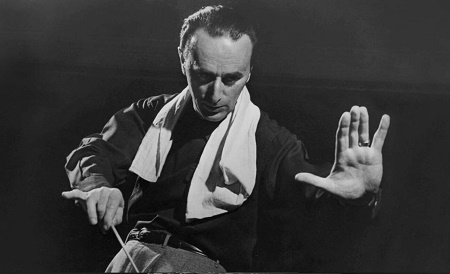

As Holocaust Remembrance Day approaches, The Colburn School is proud to announce that it has received a prestigious Save America’s Treasures grant to preserve and digitize the Herbert and Trudl Zipper Archive at Colburn. Herbert Zipper, for whom Colburn’s Zipper Hall is named, was a pioneer of the community music movement and had a deep commitment that every student should be able to participate in the performing arts. Importantly, the Zipper Archives include Herbert Zipper’s handwritten letters describing his experience at Dachau concentration camp, letters he received from his family while he was imprisoned there, identification papers from the Nazi regime, original manuscripts, photographs, extensive audiovisual materials, objects and art from his exile and travels around the world during his 92-year life.
Preservation of the Zipper Archive underscores the school’s ongoing commitment to keeping alive the history and memory of those musical pioneers impacted by the Holocaust. The school’s Ziering-Conlon Initiative for Recovered Voices is a unique Colburn resource that encourages greater awareness and more frequent performances of music by composers whose careers and lives were destroyed by the Nazi regime in Europe. James Conlon, the Artistic Director of the Ziering-Conlon Initiative for Recovered Voices at the Colburn School, has long championed works by these composers and by so doing has drawn deserved attention to composers whose names and works had very nearly been eliminated from history.
The Zipper Archive also includes material from Trudl Zipper, an influential dancer, choreographer, and teacher for whom Colburn’s Trudl Zipper Dance Institute is named. She trained with the Bodenwieser School in Vienna and was a founder of expressionist dance—now considered modern dance. From the archive, we know she collaborated with American dancers such as Isadora Duncan, a founder of the modern dance movement.
“At Colburn, we have long been dedicated to celebrating and preserving the work of those musical trailblazers who might otherwise have been forgotten by time,” said Sel Kardan, Colburn’s President and CEO. “This grant will enable us to save the Zipper Archive for future generations. The effort aligns with our Recovered Voices program and helps solidify Colburn as a leader in preserving musical history for our children and their children.”
Colburn also houses other important historical material from renowned musical artists who lived in Los Angeles. It is home to the archives of cellist Gregor Piatigorsky, one of the great musical artists?of the 20th century, and the studio of legendary violinist Jascha Heifetz. Designed by Lloyd Wright, this historical landmark once sat in Heifetz’s backyard and was saved from demolition and rebuilt on Colburn’s campus.
The grant to preserve the Zipper Archive was awarded by the National Park Service (NPS) in partnership with the National Endowment for the Arts, the National Endowment for the Humanities, and the Institute for Museum and Library Services as one of 80 similar grants across the nation totaling $24.25 million.
“Through private and public investments, the Save America’s Treasures program supports community-based preservation and conservation work on some of our nation’s most important collections, artifacts, structures, and sites for the benefit of future generations,” said NPS Director Chuck Sams.
Congressman Jimmy Gomez, whose district includes The Colburn School, said investments in preserving history like the Zipper Archive serve as a constant reminder that it is our obligation to remember the contributions of those artists who were impacted or killed during the Holocaust.
“I applaud the Interior Department’s decision to award the Colburn School a federal grant to make sure these archives and the work of composers and other artists impacted by the Holocaust continue to be preserved,” Gomez said. “Holocaust Remembrance Day on January 27 is an important reminder not only of humanity’s capacity for evil but also of the many ways in which survivors overcame this dark period of history to make meaningful contributions to society in every field of endeavor. I will continue to advocate for federal funding for local projects like these that better our communities.”
Save America’s Treasures, funded through the Historic Preservation Fund (HPF), provided $356 million to more than 1,326 projects between 1999 and 2020. Requiring a dollar-for-dollar private match, these grants have leveraged more than $500 million in private investment and contributed more than 16,000 jobs to local and state economies.
As a fervent champion of Colburn’s work, member of the Board of Directors Ann Mulally generously provided the crucial match that allowed the School to apply for this grant. Mulally’s gift also served as an important launching pad for the Zipper Archive project as the School awaited news from Save America’s Treasures.
The Zipper Archive materials date from approximately 1900-1997 and contain materials from the lives of Herbert Zipper (1904-1997), his wife Trudl Dubsky Zipper (1913-1977), and members of the immediate and extended Zipper family, including sister Hedwig “Hedy” Zipper Horwitz/Holt (1907-1989), and maternal uncle (by marriage) artist Arthur Paunzen (1890-1940).
Born in Vienna in 1904 to an assimilated Jewish family, Zipper studied at the Viennese Academy of Music and as the Nazi regime began to spread, he composed for underground theaters that had been banned by the new Austrian government. He befriended many leftist artists and musicians, including the writer Jura Soyfer, before being arrested by the Austrian police with his brother in 1938 and sent to Dachau, the first concentration camp built in Nazi Germany.
Music was, for Zipper, always a source of inspiration and resistance. One of the torture methods of the SS was to force the prisoners to sing on command, both individually and collectively. When he was commanded to sing, he chose to sing Beethoven’s “Ode to Joy” in an attempt to comfort the other prisoners.
When Zipper first arrived at Dachau, he was assigned the back-breaking job of being a “pack horse,” which meant pushing a cement truck around the camp. This had the advantage, however, of allowing him to talk to other prisoners while working; and it was here that he met up again with Soyfer. Reflecting on his time in Dachau, and this exhausting labor, he said: “I could endure running around with 100-kilogram bags of beans on my back. What I could not stand was the theft of my life.” It was this desire to maintain some semblance of life that drove him to begin to recite poetry for other prisoners. He got to know several other Jewish musicians; and persuaded some carpenters to build some string instruments illegally with stolen wood. By the beginning of July, 1938 he had assembled 14 musicians, and initiated Sunday afternoon concerts. During these illegal concerts, the musicians performed well-known classical pieces, as well as music that Zipper composed for them in the evenings after his day’s work.
Zipper also composed songs and poems together with Soyfer. One day he suggested that Soyfer compose a poem based on the infamous slogan of the camp, ‘Arbeit Macht Frei’ (Work will set you free). He memorized the poem that Soyfer recited to him a few days later, composed music to it in his head, and hummed it to some fellow prisoner-musicians. This became known as the “Dachaulied.” Soon the musicians had spread the song throughout the camp, where its martial mood and rebellious lyrics made it extremely popular. Shortly after composing the song, in September 1938, Zipper was transferred to Buchenwald. Here he was assigned to cleaning out the latrine pits, a particularly odious and dangerous job.
By this time, his parents had managed to flee to Paris, where they struggled desperately to get releases for him and his brother. In February 1939, he was informed that they were to be released. After a brief stay in Vienna they traveled to Paris, to be reunited with their family. As an enemy national, Zipper was briefly detained in a French internment camp. In May 1939, he received an invitation to be the founder and director of the Manila Symphony Orchestra. While there, he also succeeded in acquiring visas for his family to the U.S. Meanwhile, Japanese designs on the Philippines had been becoming increasingly clear, and on December 8, 1941, Japan attacked the tiny nation. In January, 1941, the Japanese army marched in, and Zipper was arrested because of his friendship with Americans in Manila. After a brief stay in jail, he was released in order to establish an orchestra intended to serve Japanese propaganda purposes. He successfully stalled on building such an orchestra, instead joining the underground resistance, as well as passing on important military information to the Americans.
Following the end of the war, Zipper and his wife decided to join his family in the US, where he worked as a composer, conductor and teacher. He was the music director of several orchestras, including the Manila Symphony Orchestra and the Brooklyn Symphony, and guest conductor for the Seoul Philharmonic. Zipper became a friend and advisor to Richard Colburn, founder of The Colburn School, where he championed the notion that a performing arts education should be available to everyone, a view that influenced Mr. Colburn as he developed his vision for Colburn’s Community School. Zipper was active in music education until his death on April 21, 1997.
About The Colburn School
Founded on the principle of access to excellence, the Colburn School has remained committed to providing the best possible performing arts education to dedicated students for over 70 years. Under the care and guidance of an exceptional faculty, generations of students have discovered and expressed their passion for music, dance, and the performing arts. Colburn recently unveiled plans for a campus expansion designed by LA native and renowned architect Frank Gehry. Born out of an aspiration to serve the community and the School, the project will add a 1,000-seat concert hall and state-of-the-art dance studios for learning and performance to DTLA. When the project is complete, Los Angeles will have the highest concentration of Gehry buildings in the world, with the Colburn expansion joining The Grand and the iconic Walt Disney Concert Hall.
For more information on The Colburn School, please visit: www.colburnschool.edu














 2 comments
2 comments


